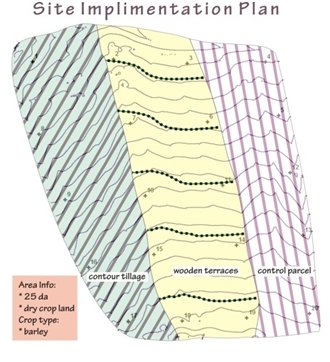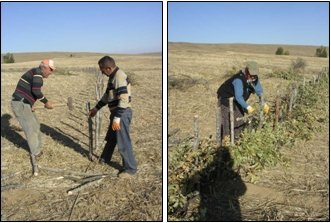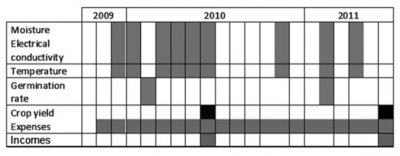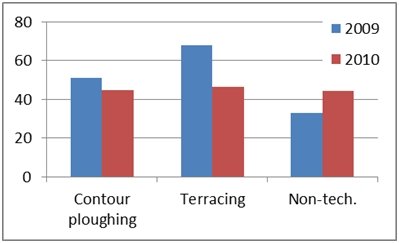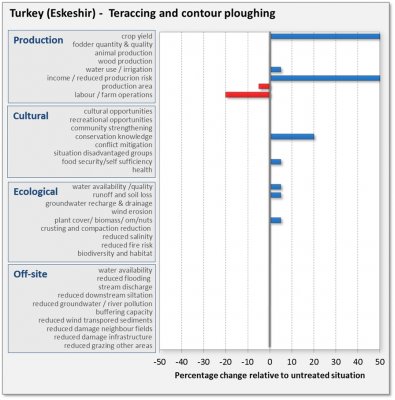| Terraces and contour tillage: experimental results and conclusions |
 |
|
Two technologies (contour ploughing and terracing) were investigated for water retention and crop growth against the conventional cultivation practice during the period December 2009 and July 2011.
Terracing in this context means that shallow levees were made along the contour lines (dashed lines in the drawing to the left). Poles are hammered on top and branches are woven between them This potentially stops the sediment and slows down runoff and when left continuously, a sloping terrace would eventually form. The tillage between these fences is along the contours. The left hand plot was done with contour ploughing only. The right hand plot uses the conventional tillage along the slope as it gives the longest seed lines.
Germination rate was determined by counting the individual sprouts in m² once within January in the early sprouting period. Crop yield assessment was made during the harvest at the end of growing season.
The result shows that the water content (WC) of the soils vary seasonally. During the monitoring period (Nov 2009 – June 2011) contour tillage technology results in a slightly higher WC (Figure below). Terracing gives second best results though non-technology area exhibit higher WC in the winter months. The differences might also be caused by soil variation. In any case, the differences are not significant, certainly not in a sense of crop water availability.
It appears that during the first year, seed germination rate was the highest in the terraced plot as compared to contour and conventional tillage, while in the second year these differences were not observed. This shows that inter-annual variability is sometimes large and not all effects should be contributed to the technology.
Summary of yields in kg/ha, expenses (between brackets) and income for the two years. Monetary unit is Turkish Lyra. Note that there is an initial expense to create the levees of 2170 TL.
The stakeholders meeting showed the importance of bringing solutions to this degradation trend which threats both the environment and the farmers’ income. The farmers experience shows that barley is the most appropriate crop for the terrace and the contour ploughing technologies. Stakeholders were passively involved in the construction of wooden terraces as observer. In the last harvesting season, stakeholders visited mutually the implementation area and discussed the technologies. By using their own experiences they found that barley crop in terraced and contour ploughed spots are more robust compared to control parcel. Stakeholders mostly think that due to low rainfall rates throughout the growing season 2009 and lack of fallow in our application radically decreased the effectiveness of the technologies applied. In a wider sense they believe that the population is becoming older due to intense migration of young people to big cities for economic reasons, which puts an extra stress on implementing technologies at a larger scale.
However some training is needed for implementing in steeper slopes. Also smaller tractors with more manoeuvre capability will be better in cultivating terraced land.
|
|||||||||||||||||||||||||||
Study sites
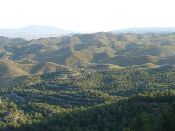
Acknowledgement
The DESIRE project was
|
DESIRE brought together the expertise of
26 international research institutes
and non-governmental organisations.
This website does not necessarily
represent the opinion of the
European Commission. The European
Commission is not responsible for
any use that might be made of the
information contained herein. 


